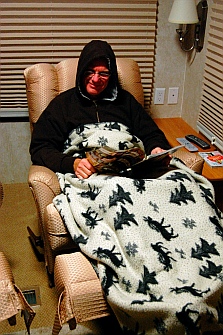With these cold days and nights, you might find these interesting.
Open the link to see the options, and installation of a heater that uses far less propane than a furnace, even if you are not boondocking.

Brrr! The night before the installation
"We froze in our trailer during the winter of 2007-08 in Arizona. Morning temperatures in the kitchen were often 47 degrees, and although daytime kitchen temps could get as high as 70 degrees (even 80 on those days we baked a chicken in the oven), as soon as evening came, the temps dropped into the low 60's or high 50's. Brrr!
It's hard to sit around in the evening in those kinds of temperatures. Most trailers (ours included) come equipped with a propane furnace. However, these loud, inefficient beasts use a lot of electricity, and can drain the batteries in one night.
That first winter we discovered that the more experienced winter desert boondockers installed vent-free propane heaters in their rigs. These are wonderful little appliances that use far less propane than a furnace and no electricity at all. When we bought the Hitchhiker fifth wheel in May, 2008, we decided we would install one.
All summer long we thought about the project, but never found ourselves in a town where there was a good selection of heaters to look at or anyone knowledgeable about installing them in RVs. So we dawdled.
As the nights got colder in late November, 2008, and we relied more and more on our trailer's electricity-eating furnace, we found ourselves in the warm company of our good friends Bob and Donna Lea Jensen and their vent-free, electricity-free propane heater. Bob has installed quite a few of these little devils and he gave us some hints and loaned us two critical tools for the project: a pipe cutter and a flaring tool. We learned a lot through all this, and I thought it might be helpful to others to include some notes here about our project: http://roadslesstraveled.us/Heater.html
WHICH VENT-FREE HEATER? After baking ourselves till golden brown on our first night with our new vent-free heater, we sorted out which windows to crack open and where best to place the heater."
From: Roads Less Traveled
__________________
More at:
Is your furnace eating you out of RV and home? http://www.newrver.com/article_249.shtml
__________________
More heater choices: http://www.associatedcontent.com/article/2525431/propane_and_catalytic_heaters_for_your.html?cat=27
__________________
Why Cold Weather Can Be Just as Dangerous for Your Pet as the Sweltering Days of Summer

The sweltering days of summer aren’t the only time of year that can be dangerous for beloved pets.
Winter weather also requires pet owners to take precautions to keep furry family members warm, safe and in good health.
The ASPCA offers some great advice for keeping your dog or cat safe from winter hazards.
"Ten Cold Weather Tips for Pet Owners
Keep your cat indoors. Kitties allowed to wander unsupervised outdoors are at much greater risk than housecats, no matter the time of year. But a cat left outside in cold weather can literally freeze to death, or become permanently lost or stolen while looking for shelter from the cold. Even if your kitty lives indoors, a cat collar with an ID tag is an excellent investment.You keep your cat inside, but your neighbors may not, or there could be strays or feral cats in the area. Kitties left out in cold temperatures will sometimes tuck themselves up under the hoods of cars, or in the wheel wells. Starting or moving the vehicle can hurt or even kill the animal.
During the winter months, it’s a good idea to bang loudly on your car hood before starting the engine as a warning to a cat that might be in or around your vehicle.
Keep your dog on his leash when you’re outside with him, and make sure his ID tag is current. More dogs go missing in the winter than any other time of the year. It’s very easy for pups to lose their scent and get lost when snow or ice is on the ground, and especially during snowstorms.
Snow accumulation can make it impossible for your dog to know if he’s in his front yard or standing out on a street or highway. Light-colored dogs with snow on their fur can quickly blend into the background, making them nearly impossible to spot.
Thoroughly wipe off your dog’s feet, legs and underside after she’s been out in snowy or icy conditions. It’s possible she picked up salt crystals, antifreeze or some other toxic chemical on her paws, which she could later ingest by licking the area.
Be especially careful not to leave antifreeze leaks or spills where your pet can sample them. Antifreeze is lethal to dogs and cats. Also check your dog’s paw pads for any signs of injury or bleeding from walking on frozen or snow-packed surfaces.
Don’t shave or clip your dog’s coat too short during the winter months. A longer coat will keep him warmer. If your pup has short hair, a doggy sweater might be in order, especially if he’s a small breed, an older fellow, has arthritis or other joint problems, or if he’s prone to shivering.
Consider paper training a puppy if you get her during cold weather. Puppies don’t handle frigid temps as well as older dogs do. If you add a puppy to the family during the winter months, you may find housebreaking her more of a challenge than you expected. If so, you can paper train her instead, then retrain her to potty outdoors when the weather warms up.
If you and your dog participate in lots of outdoor winter activities, make sure his species-appropriate diet has sufficient calories and protein to meet his energy requirements. This may mean increasing his meal portions during the winter months.
If, on the other hand, you and your pet tend to hibernate during cold weather, it’s important not to let your dog lose muscle tone and physical conditioning. You’d be amazed at the number of canine knee, soft tissue, cervical disc and neck injuries I see in my veterinary practice each spring.
These problems occur most often in out-of-shape dogs that go from zero to 60 on the first warm day of late winter or early spring. There are many creative ways to keep your pet active during cold weather
Don’t leave your pet outside in the car. Just as your vehicle can become an incinerator during hot weather, it can become a freezer, holding in the cold air, during the winter. While not as common as pets expiring in hot cars in the summer, too many precious dogs and cats have frozen to death in a cold car.
Make sure your pet has cozy, draft-free winter sleeping quarters. If your dog has her own crate, make sure her winter bed inside it is one that will keep her warm. Kitty should have a snug sleeping spot as well, with warm bedding she can curl up in.
Give your frail or older pet some extra TLC. Cold winter temperatures can be especially hard on a senior pet or a dog or kitty with degenerative joint disease or another chronic, debilitating condition. Talk with your integrative or holistic vet about physical therapy treatments and other safe, natural methods for improving your pet’s comfort and mobility during cold weather. "
The links there are also interesting, and give advice about potty training, arthritis therapy, etc.
From : http://healthypets.mercola.com/sites/healthypets/archive/2011/01/13/preparing-your-pet-for-dangers-in-winter.aspx
_______________
Also, it stands to reason, that you don't leave your dog outside in this cold weather without a really cozy dog house, with clean soft bedding. Unless you are mushing Iditarod huskies in Alaska, as they have the right fur, and are used to it!
____________________
Today:
It was overcast and still chilly, but not quite as bad as the last few days. It was 47 deg. at noon.
The foster cats didn't believe me, so I let them out on the screen porch, but it didn't take them long to find out that "Momma knows best", and were glad to come back in again.
Jay put some more insulation up in the cargo trailer, while I pondered, fussed, fumed, plotted and measured where the new/old little fridge would fit, without sticking out in a doorway. I had thought about putting it over the AC, which will be at the bottom of the closet, but it is too deep. Finally, I decided to put it under the sink, not ideal, but at least it won't be in the way.
With that decision made, we could start making the base for the AC to sit on. We cut the plywood base, and the wedges for the plywood to raise it up enough to drain to the outside.
That will be covered with a galvanized pan, which we will have to brake (bend), to the right dimensions, on another day.















4 comments:
What a great and thorough post on heaters. We have needed/wanted one but were totally confused on what to get. We have cats and they like to rub against the heater,so wehave to watch the
m all the time. We only run ours when we are watching them.
Thanks for the excellent post.
We have the Olympian Wave 8 in our rig... it's wonderful and heats our 40ft motorhome with ease. We love it! No noise and less propane used and no power draw for boondocking.
We used to have a blue flame heater in our house, to supplement our big furnace. But it seemed to leave a bluish oily *film* on the window glass and patio doors and glass lamp shades. We gave it away to our folks for in their house in Florida, they didn't care about the film, they just wanted it to take the chill out in the cold mornings.
Sooo we took the Olympian in from the motorhome and hung it in the house where the blue flame was! Then before our vacation in Feb, we will bring it back out to the rig and re-install in there.
~*~*~*~*~*~*~*~*~*~*~*~*~*~*~*~
Karen and Steve
(Our Blog) RVing: Small House... BIG Backyard
http://kareninthewoods-kareninthewoods.blogspot.com/
Thank you for your comments, both Karens.
Karen, I am so glad to be of help.
Karen in The Woods, that is very good information which will be very helpful for those trying to make a choice.
Happy Trails, Penny, TX
Had seen you postings on other Blogs and just started checking out yours. I find it filled with informative, interesting material, making for very enjoyable reading. I found the articles on the quality of beef we eat and the cargo trailer conversion to be very interesting. Thanks
Marty
Post a Comment